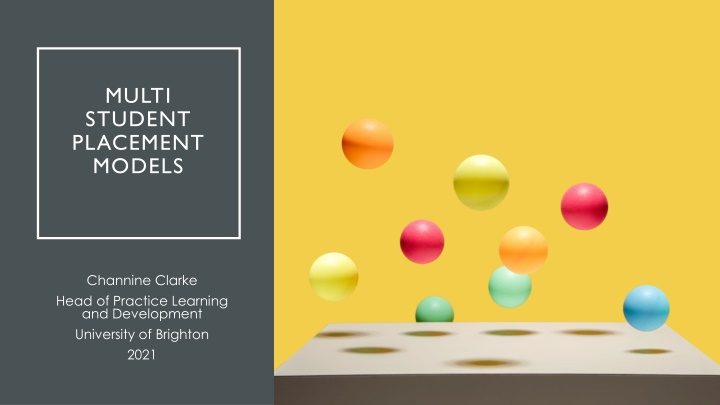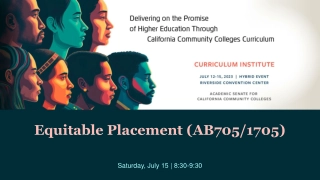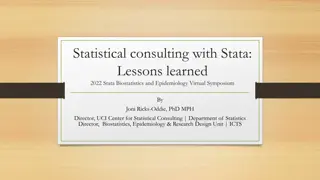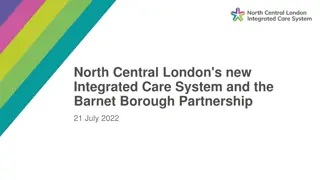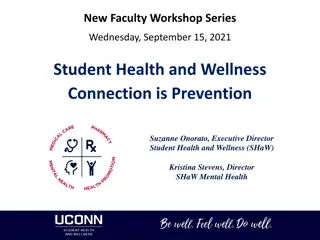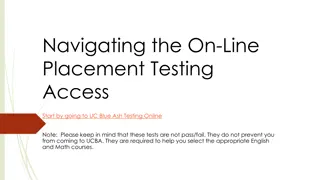Diverse Models of Student Placement in Health and Social Care Education
Explore a range of innovative student placement models used at the University of Brighton, focusing on enhancing learning and increasing placement capacity. From peer-assisted mentoring to hybrid approaches, these models offer unique opportunities and challenges for educators and students alike. Additionally, discover new initiatives such as leadership placements, interprofessional collaborations, and digital learning experiences, highlighting the evolving landscape of practice education in allied health and social care professions.
Download Presentation

Please find below an Image/Link to download the presentation.
The content on the website is provided AS IS for your information and personal use only. It may not be sold, licensed, or shared on other websites without obtaining consent from the author.If you encounter any issues during the download, it is possible that the publisher has removed the file from their server.
You are allowed to download the files provided on this website for personal or commercial use, subject to the condition that they are used lawfully. All files are the property of their respective owners.
The content on the website is provided AS IS for your information and personal use only. It may not be sold, licensed, or shared on other websites without obtaining consent from the author.
E N D
Presentation Transcript
MULTI STUDENT PLACEMENT MODELS Channine Clarke Head of Practice Learning and Development University of Brighton 2021
AIM The session will: Present different multi student models for placements with the overarching aim of increasing placement capacity and enhancing learning. Consider opportunities and challenges of the various models Identify key actions that could be taken you and you and your teams
MODELS USED AT UNIVERSITY OF BRIGHTON MODEL DESCRIPTION One-to one Peer-assisted mentoring Near-peer mentoring Team model Multiple mentoring Long-arm supervision Project focused Hybrid approaches One educator supervising and assessing one student. Two or more students concurrently working with one educator, with an expectation that the students work together in ways that facilitate learning, Two or more students of varying experience whereby the more experiences student mentors the less experienced student with an educator providing a supervisory overview. Two or more educators sharing the supervision and assessment of one student A team of educators supervising and assessing a team of students (essentially a combination of team and peer-assisted models). Supervision is provided by an experienced clinician who is not based at the same location as the student . Practice education placement in which a student focusses on a project, and may not complete any clinical work. Combinations of two or more distinct approaches, typically to deliver practice education in specific contexts e.g. peer-assisted and blended.
MODELS ALSO BEING USED DESCRIPTION Students on a leadership placement with an OT Lead or AHP Lead or split between a group of leads (either clinical or non-clinical). UoB, Kent and Medway, SCfT (PT lead), SaBPfT. All remote. An interprofessional collaboration with Worthing hospital who are opening interprofessional clinical education ward. This will be staffed primarily by students (mainly Nursing) with hub and spoke input from OT and PT students and with appropriate support and supervision from educators. MODEL Leadership placements Clinical education ward - includes a hybrid of inter professional; and hub & spoke The Peer Enhanced e-learning Placement (PEEP) University of East Anglia University based digital learning involving the use of case studies and simulation, created to mirror (as much as possible) a face to face placement but delivered via the virtual learning environment. It offers shared group learning, integration of theory to practice, reviews, reflection practice and collaboration between peers (including interprofessional peers). We will be frontloading our BSc intermediate placement with a 3 week PEEP course and they will then follow this up with a 3 week clinical practice placement. We will be collaborating with London South Bank University and our Nursing team on developing case studies. Research Placement Part of diverse, working with a group of MND researchers with UoB and clinicians with Sussex Community NHS Trust.
A mapping review of models of practice education in allied health and social care profession KEY MODELS (BEVERIDGE & PENTLAND, 2020) Literature review of 57 papers from AHP, nursing, social work and pharmacy. Online survey: 311 - Occupational therapists, 32 - Practice Placement Tutors and 177 students Workshops and interviews 14 different practice placement models Described in terms of: Student-educator ratio Key learning mechanisms Service or practice focus None that appeared unfeasible in UK Feasibility determined by local context and good communication between HEI and educators
1. No obvious impediments to the use of the models were identified. FEASIBILITY OF DIFFERENT MODELS BEVERIDGE & PENTLAND, 2020 2. Feasibility and effectiveness are likely to be determined by local conditions. 3. Careful preparation is key to effecting the quality of the learning experience. 4. Initial concerns about feasibility tend to dissipate over time with familiarity of model(s) used.
In your group discuss and share your experiences of : what you feel the benefits, opportunities and challenges for the multi-student models might be BREAKOUT ROOM How you could overcome the challenges What support do you need to trial new approach? (15 mins)
What were main opportunities and barriers areas each group highlighted? GROUP FEEDBACK What strategies did you identify? What support do you need?
SURVEY OF DIVERSE PLACEMENT EDUCATORS (ON- SITE & LONG-ARM OT) ON 2:1 MODEL (UNIVERSITY OF BRIGHTON, 2020) PERCEIVED BENEFITS TO THE ORGANISATION "A creative approach": More students add positively to service input and output. Raises profile of OT and value added to employability. TO THE EDUCATOR Self and professional development. Increases student autonomy and could reduce pressure on educators. PERCEIVED CHALLENGES TO THE ORGANISATION Resources: space and equipment. Time commitment, taking away from usual work. TO THE EDUCATOR Time commitment If student needs are different, educator needs to be adaptable to ensure individualised learning objectives.
SURVEY OF DIVERSE PLACEMENT STUDENTS (2018 COHORT) ON 2:1 MODEL (UNIVERSITY OF BRIGHTON, 2020) PERCEIVED BENEFITS TO THE STUDENTS Support each other - 'bounce ideas' together. Peer challenge and reflection between each other The effective use of joint supervision can have a positive impact on overcoming challenges and learning from each other PERCEIVED CHALLENGES TO THE STUDENTS If they do not work well together due to learning needs, personality or learning style differences. If one student feels the need to 'carry' the other, which hides learning needs which hides learning needs of the one being carried .
CHALLENGES Increased pressures on office space (Kinsella and Piersol, 2018). Possible reduced opportunities to work with service users (Kinsella and Piersol, 2018; Price and Whiteside, 2016). Reduced time for student supervision (Briffa and Porter, 2013) CHALLENGES FOR PEER-ASSISTED MODEL (BEVERIDGE & PENTLAND, 2020)
OPTMISING THE 2:1 (PEER ASSISTED) MODEL (BEVERIDGE & PENTLAND, 2020) STRATEGIES FOR 2:1 (PEER ASSISTED) MODEL Preparing students and educators. Ensuring facilitation of peer-feedback supervision (Blakely et al., 2009; Briffa and Porter, 2013; Lynam et al., 2015). Advance preparation to ensure effective organisation and achievement of learning outcomes (Hanson and Deluliss, 2015). Careful pre-placement consideration given to matching student peers based on academic experience and performance and potential personality clashes (Briffa and Porter, 2013; Kinsella and Piersol, 2016). Success reported from educators were based on Use of evidence-based approaches. Careful preparation. Utilising organisational support. Being positive about 2:1 whilst remaining pragmatic about expectations (Price and Whiteside, 2016).
Explore the models and consider hybrids: Try being a new multi- student champion Look at capacity and resources of setting. Be creative and innovative ; students can share the time on site if space is an issue Joint supervision or a team approach may mitigate issues regarding time commitment. This can be transient e.g. at beginning and end of the placement, it may be more appropriate to have individual supervision. SOME OVERALL SUGGESTIONS WHEN CONSIDERING A DIFFERENT MODEL Use support workers and others in your team to be engaged with student education and it helps with their CPD too (Facilitating learning is one of the 4 pillars) Students identify their learning styles and weekly objectives for working together, encourage them to become critical friends We will also look at compatibility /skill set if students are placed together. Always use the HEI to help support you
REFERENCES Beveridge J & Pentland D (2019) Practice education in the UK: A comparative cross-sectional investigation of key stakeholders perspectives (Abstract). In: RCOT 2019 Annual Conference and Exhibition 17-18 June 2019 Book of Abstracts. British Journal of Occupational Therapy, 82(8 suppl.), p. 3. Beveridge J & Pentland D (2020) A mapping review of practice education in allied health and social care professions. British Journal of Occupational Therapy. Epub ahead of print 3 March 2020. doi.org/10.1177/0308022620904325. Blakely, C, Rigg, J, Joynson, K, et al. (2009) Supervision models in a 2:1 acute care placement. British Journal of Occupational Therapy 72(11): 515 517. Briffa, C, Porter, J (2013) A systematic review of the collaborative clinical education model to inform speech-language pathology practice. International Journal of Speech-Language Pathology 15(6): 564 574. Hanson, DJ, DeIuliis, ED (2015) The collaborative model of fieldwork education: A blueprint for group supervision of students. Occupational Therapy in Health Care 29(2): 223 239. Kinsella, AT, Piersol, CV (2018) Development and evaluation of a collaborative model level II fieldwork program. Open Journal of Occupational Therapy (OJOT) 6(3): 1 14. Lynam, A, Corish, C, Connolly, D (2015) Development of a framework to facilitate a collaborative peer learning 2:1 model of practice placement education. Nutrition & Dietetics 72(2): 170 175. Price, D, Whiteside, M (2016) Implementing the 2:1 student placement model in occupational therapy: Strategies for practice. Australian Occupational Therapy Journal 63(2): 123 129. Royal College of Occupational Therapists (2019).A review of Rcots role supporting practice education. Summary of Key Findings. London: RCOT
